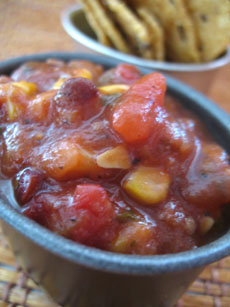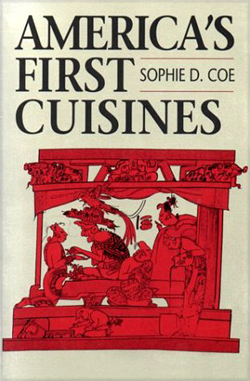

Salsa and tortilla chips. Photo of Jardine’s salsa by Melody Lan | THE NIBBLE.
|
KAREN HOCHMAN is Editorial Director of THE NIBBLE.
|
|
May 2007
Updated August 2009
|
 |
The History Of Salsa
Ancient Condiment And Contemporary Dance
CAPSULE REPORT: Salsa, which has been America’s favorite condiment since 2000—supplanting ketchup—actually has been a favorite condiment for thousands of years. The chile has been domesticated since about 5200 B.C.E., and tomatoes by 3000 B.C.E. both in Central America. The two were combined into a condiment, which the Conquistadors named “salsa,” or sauce. The spicy sauce gave name to a hot and spicy late 20th century dance related to the mambo...but that’s just the tail end of the story. This is Page 1 of a three-page article. Click on the black links below to visit other pages.
Overview
Salsa is the Spanish word for sauce, but the food predates the Spaniards by many centuries. Tomato is the base of salsa: The wild tomato is indigenous to Ecuador and Peru, but the Aztecs and other Central American nations were the first to domesticate it. The tomatillo—which is not a green tomato but a member of the nightshade family[1] that includes the cape gooseberry (their closer relation) as well as the tomato—also originated in the Andes, in the area that is now Ecuador, Colombia and Peru.
[1] Nightshades are members of the Solanaceae family of flowering plants, many of which are edible, while others are poisonous (some have both edible and toxic parts). The name of the family comes from the Latin Solanum, “the nightshade plant.” Other edible members include capsicum (the chiles), Chinese lanterns, eggplants, garden huckleberry, ground cherry, naranjilla, pepinos, peppers, potatoes and the tree tomato. One thing that sets these nightshades apart is their alkaloid content. Alkaloids are harmful nitrogen compounds which, in high quantities, are toxic, causing nausea, diarrhea with vomiting and headaches. In extreme cases they lead to unconsciousness and convulsions to the point of respiratory paralysis. That’s why the tomato was considered poisonous by Europeans and not eaten for 200 years following its discovery. Alkaloids exist in tiny, non-harmful quantities in the nightshade foods we eat. Tobacco and the petunia are also members of the family, as well as the Datura or Jimson weed, the mandrake and the deadly nightshade or belladonna.
The making of a sauce by combining chiles, tomatoes and other ingredients like squash seeds and even beans has been documented back to the Aztec culture. We know this from Bernardino de Sahagún, a Franciscan missionary sent to “New Spain” (Mexico) in 1529, after the Aztec Empire was conquered by Hernando Cortes. He remained there for the rest of his life, 60 years. In addition to his missionary work, he undertook extensive scholarly work, including what is now known as the Florentine Codex, one of the richest surviving sources of information on Aztec life before the conquest. His extensive writings documented every food common to the culture. In this excerpt, describing the food vendors in the large Aztec markets, he describes many of the ingredients in modern salsas:
“He sells foods, sauces, hot sauces, fried [food], olla-cooked, juices, sauces of juices, shredded [food] with chile, with squash seeds, with tomatoes, with smoked chile, with hot chile, with yellow chile, with mild red chile sauce, yellow chile sauce, sauce of smoked chile, heated sauce, he sells toasted beans, cooked beans, mushroom sauce, sauce of small squash, sauce of large tomatoes, sauce of ordinary tomatoes[2], sauce of various kinds of sour herbs, avocado sauce.”
[2] Believed to be the tomatillo. Cited in America's First Cuisines, by Sophie D. Coe.
Continue To Page 2: Salsa Chronology
Go To The Article Index Above |
 |

|



